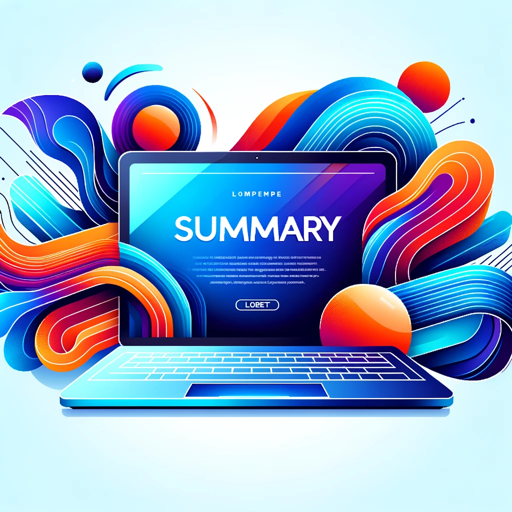Résumé d'article-AI-Powered Summary Tool
AI-driven summaries at your fingertips
Réalise la synthèse de l'article suivant :
Related Tools
Load More
論文要約くん
落合陽一先生の論文読み方フォーマットで論文を分かりやすく解説してくれます。論文を全文読み、詳細な解説を提供します。プロンプトはいりません、PDFかURLを送るだけです。

Scientific Article Summarizer
In-depth and versatile summarizer of scientific articles, providing detailed explanations and examples.

TLDR Article Summarizer
Summarize articles and web pages: Provides an overview, evaluates pros and cons, poses insightful questions for deeper exploration of the topic, and suggests related articles | #Webpage #Tab #Hoarder #TL;DR #AISalon
Résumé articles LEC
Permet de faire un résumé en 2 paragraphes d'un article pour la section "L'article en bref"

Rédaction SEO
Textes optimisés pour le référencement naturel. Donne tes mots-clés et je rédige un article de A à Z, j'optimise un texte existant ou je crée un article de netliking

Academic article Summery
Takes and articles and summarises the key elements
20.0 / 5 (200 votes)
Introduction to Résumé d'article
Résumé d'article is designed to assist users in quickly understanding the core content of texts such as news articles, blog posts, research papers, and other written documents by providing clear and concise summaries. The primary function is to save time for users by distilling large amounts of information into digestible, key points. This tool can be particularly useful in a variety of scenarios where users need to stay informed but have limited time to read full texts. For example, a business executive may need to quickly review multiple market analysis reports to make strategic decisions. Instead of reading each report in its entirety, they can rely on Résumé d'article to provide summaries that highlight the most important data and insights. Similarly, a student conducting research for a thesis might use Résumé d'article to sift through academic papers and identify which ones are most relevant to their topic of study. The design purpose of Résumé d'article is rooted in enhancing productivity and efficiency, making it an invaluable tool for anyone dealing with large volumes of textual information.

Main Functions of Résumé d'article
Summarization of Long-Form Content
Example
A news analyst needs to stay updated with daily news but lacks time to read multiple articles in full. Résumé d'article provides summaries of the most relevant articles, allowing the analyst to quickly grasp key points and trends without spending hours reading.
Scenario
This function is applied in scenarios where professionals or individuals need to stay informed about current events, trends, or developments but have time constraints. For instance, a policy advisor may use this function to quickly review legislative updates from various sources.
Extraction of Key Points from Research Papers
Example
A medical researcher wants to review recent studies on a specific topic but is overwhelmed by the volume of research available. Résumé d'article summarizes the papers, highlighting the hypothesis, methodology, results, and conclusions, allowing the researcher to identify the most relevant studies quickly.
Scenario
This function is particularly useful in academic and scientific settings where researchers and students need to review vast amounts of literature. It helps in identifying the most pertinent research papers without the need to read each paper in detail.
Generation of Executive Summaries
Example
A project manager needs to report on the progress of a project to stakeholders but wants to avoid overwhelming them with too much detail. Résumé d'article can generate an executive summary that focuses on the key achievements, challenges, and next steps, facilitating clear communication.
Scenario
This function is ideal for business settings where concise communication of complex information is needed. It helps in preparing reports, meeting notes, or strategic summaries for stakeholders, ensuring they are well-informed without being bogged down by excessive detail.
Ideal Users of Résumé d'article Services
Professionals and Executives
Professionals, such as executives, managers, and analysts, are key users of Résumé d'article. These individuals often have to process a large volume of information daily, including market reports, internal documents, news articles, and research papers. By using Résumé d'article, they can quickly access the most pertinent information without needing to read every document in full, thereby saving time and making more informed decisions.
Academics and Researchers
Academics and researchers are another primary user group for Résumé d'article. These individuals frequently need to review and synthesize a large number of academic papers and studies. Résumé d'article aids them by providing summaries that capture the essence of each paper, allowing them to identify the most relevant research quickly. This is especially beneficial in fields with extensive literature, such as medicine, social sciences, and engineering.

How to Use Résumé d'article
Visit aichatonline.org
Access aichatonline.org for a free trial without the need for login or a ChatGPT Plus subscription. This step allows you to explore the tool's capabilities with no upfront commitment.
Upload or share your article
Provide the text, article, or document you want summarized. You can either upload a file or paste the content directly. The tool supports a variety of formats, making it flexible for different use cases.
Select your summarization preferences
Choose the desired length and level of detail for your summary. You can opt for a brief overview or a more detailed summary, depending on your needs.
Review and refine
Once the summary is generated, review it for accuracy and completeness. You can make adjustments or request a re-summary if needed, ensuring the output meets your expectations.
Download or share the summary
Save the summarized content to your device or share it directly through various channels. This step ensures that your summarized information is readily accessible for further use.
Try other advanced and practical GPTs
Network Systems Administrator and Security Expert
AI-Powered Network and Security Expert

THE CREATOR - WorldBuilder Fantasy GPT App
AI-powered world-building for creators

Ra
AI-Powered Spiritual Guidance

GPTLaw
AI-Powered Legal Education Assistant

EasyEssay
AI-powered essay writing simplified.

Ecrire un livre
AI-powered book writing made easy

CleanGPT
AI-Powered Solutions for Every Task

Narrativ Nexus
Craft Your Story with AI Precision

Gerador de Prompts Perfeitos
AI-powered prompt creation made easy.

Harvest
AI-Powered Spiritual and Character Growth

[FunGPT]: Text to MP3/MP4
AI-Powered Text to Audio/Video Conversion
![[FunGPT]: Text to MP3/MP4](https://files.oaiusercontent.com/file-yaC8xyD55kRJaBJ53CIu9Aq9?se=2123-12-20T04%3A47%3A39Z&sp=r&sv=2021-08-06&sr=b&rscc=max-age%3D1209600%2C%20immutable&rscd=attachment%3B%20filename%3D5d501fe0-888f-4826-bd99-ad4aab67f414.png&sig=hIN44bDWvMfm402M7gFoNkZpv%2BVkRrMrbolrshn77AU%3D)
Business Mentor
AI-Powered Business Insights and Planning

- Academic Writing
- Business Reports
- Blog Posts
- Research Summaries
- Content Curation
FAQs About Résumé d'article
What type of documents can I summarize with Résumé d'article?
Résumé d'article supports a wide range of documents including articles, research papers, blog posts, reports, and more. You can upload text in various formats such as PDF, Word, or plain text.
How accurate are the summaries generated?
The accuracy of the summaries depends on the complexity of the original content. Résumé d'article uses advanced AI to generate concise and relevant summaries, but reviewing the output is recommended to ensure it meets your needs.
Is there a word limit for the documents I can summarize?
While there is no strict word limit, very large documents may take longer to process. For best results, it's advisable to summarize documents in sections if they are particularly lengthy.
Can I customize the level of detail in the summary?
Yes, you can choose between a brief summary, a medium-length summary, or a detailed summary. This flexibility allows you to tailor the output to your specific requirements.
Is Résumé d'article suitable for academic use?
Absolutely. Résumé d'article is ideal for summarizing academic papers, research articles, and other scholarly texts, making it a valuable tool for students and researchers.